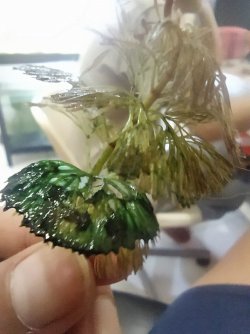shaziasadiqah
Fish Fanatic
This morning i saw this green thingy on one of my plant, then i remove it by cutting the plant and take a closer look.
I'm not sure if it's blue green algae (cyanobacteria) but i'm kinda pretty sure because it has a smell to it, it's like the kind of earthy smell.
Right now i don't do anything with the tank and no other this green thingy inside my tank other than on this plant but should i treat the tank with something or do something else? tomorrow is the tank's water change schedule and i usually do a 50% water change weekly.
If it is a blue green algae (cyanobacteria) i'm worry if that will harm my fishes and other plants, too.
Water parameter:
Amonia 0
Nitrite 0
Nitrate around 10 to 20 ppm
I dose Tropica specialized nutrition and ADA Iron every week after water change and i usually put Tetra Initial Sticks every month.
it's a 33gal tank with 12 ember tetra, 6 albino cories, 6 kuhli loach and a pair of honey gourami, feed them twice a day.
I set my light on a timer for 8 hours a day from 7 am to 3pm, i use a cheap light from my LFS 25watt if i remember correctly.
I have sponge filter and a 750 liter per hour HoB.
Please help, thank you
I'm not sure if it's blue green algae (cyanobacteria) but i'm kinda pretty sure because it has a smell to it, it's like the kind of earthy smell.
Right now i don't do anything with the tank and no other this green thingy inside my tank other than on this plant but should i treat the tank with something or do something else? tomorrow is the tank's water change schedule and i usually do a 50% water change weekly.
If it is a blue green algae (cyanobacteria) i'm worry if that will harm my fishes and other plants, too.
Water parameter:
Amonia 0
Nitrite 0
Nitrate around 10 to 20 ppm
I dose Tropica specialized nutrition and ADA Iron every week after water change and i usually put Tetra Initial Sticks every month.
it's a 33gal tank with 12 ember tetra, 6 albino cories, 6 kuhli loach and a pair of honey gourami, feed them twice a day.
I set my light on a timer for 8 hours a day from 7 am to 3pm, i use a cheap light from my LFS 25watt if i remember correctly.
I have sponge filter and a 750 liter per hour HoB.
Please help, thank you



